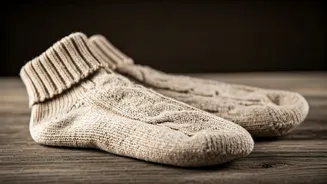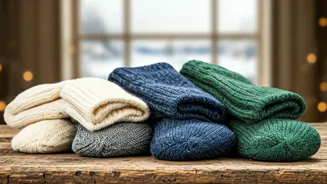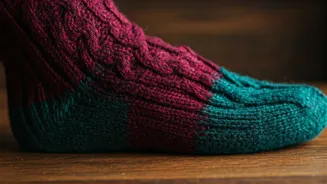Material Matters Most
The construction material plays a crucial role in the warmth and comfort of winter socks. Wool is a time-tested favorite, renowned for its superior insulation
capabilities, even when wet. Merino wool, in particular, offers a softer feel and enhanced breathability, ideal for active pursuits. Synthetic fibers, such as polyester and acrylic, provide excellent moisture-wicking properties, crucial for keeping feet dry and preventing chills. Blends that combine wool with synthetics can offer a balance of warmth, durability, and moisture management. The choice of material should depend on the expected activities and weather conditions.
Wool: The Champion
Wool, especially Merino wool, reigns supreme when it comes to keeping your feet warm in winter. Its natural fibers trap air, creating an insulating barrier against the cold. Moreover, wool can absorb a significant amount of moisture without feeling damp, ensuring your feet stay dry and comfortable. Merino wool stands out due to its finer fibers, resulting in a softer, less itchy feel compared to traditional wool. The natural crimp in wool fibers also enhances its breathability, allowing for some airflow and preventing overheating. This makes wool socks suitable for a range of activities, from casual wear to skiing or hiking.
Synthetics: Moisture Wizards
Synthetic materials like polyester and acrylic excel at wicking away moisture, a crucial function for maintaining warmth in cold weather. These fibers are designed to draw sweat away from the skin, preventing it from cooling and causing discomfort. While synthetics may not provide the same level of insulation as wool, their ability to keep feet dry is invaluable. They also tend to be more durable and less prone to shrinking than natural fibers. Some winter socks incorporate a blend of wool and synthetics to benefit from the strengths of both materials. The blend can combine wool's insulating properties with synthetics' moisture-wicking and durability advantages.
Consider Sock Construction
Beyond materials, the construction of winter socks influences their performance. Look for features like reinforced heels and toes to enhance durability and prevent wear and tear. The thickness of the sock is another significant factor; thicker socks generally provide more insulation but may also require more space in your shoes. Consider the sock's knit construction. A dense knit provides better insulation, while a looser knit might offer more breathability. Some socks have specific designs for different activities, such as padded zones for hiking or compression features for improved circulation. The right construction elements depend on your use case.
Sizing and Fit
Achieving the correct fit is critical for the effectiveness of winter socks. Socks that are too tight can restrict circulation, potentially making your feet colder. Conversely, socks that are too loose can bunch up and cause blisters. When selecting a size, consider the thickness of the socks and the shoes you'll be wearing them with. A slightly larger shoe size might be necessary to accommodate thicker winter socks. Before purchasing, check the sizing chart provided by the sock manufacturer. Also, ensure the socks cover your ankles adequately, as exposed skin is a prime spot for heat loss. Always test the fit with the shoes you intend to use.
Styles: Choose Wisely
Winter socks are available in various styles, each suited for different needs. Crew socks offer a good balance of coverage and versatility, making them ideal for everyday wear. Over-the-calf socks provide extra warmth and protection, particularly useful in boots or colder environments. For outdoor activities, consider hiking socks, which often feature reinforced areas and targeted cushioning. If you are participating in sports, performance socks may offer features like compression and enhanced breathability. Consider the specific activities you plan to undertake when selecting the style. Your choice should align with the footwear and the weather conditions you'll be facing.
Maintenance and Care
Proper care and maintenance can extend the lifespan and performance of your winter socks. Always follow the care instructions provided on the socks' label. Most wool socks should be washed in cold water with a gentle detergent to prevent shrinking. Synthetic socks are typically more durable and can withstand machine washing. Avoid using bleach, which can damage the fibers. Air-drying is recommended, as high heat from a dryer can degrade the material. Storing your socks properly, such as folding them neatly or rolling them to prevent stretching, will help them maintain their shape and effectiveness. By taking care of your socks, you ensure they continue to provide warmth and comfort season after season.










